Across today’s tech landscape, managed service providers (MSPs) are increasingly turning to software-as-a-service (SaaS) and desktop-as-a-service (DaaS) solutions to streamline IT management, bolster scalability, and fortify security measures for their customers. While industry heavyweights like Microsoft Azure, Amazon Web Services (AWS), and Broadcom VMware solutions dominate the conversation for these applications, Citrix Systems Inc. (Citrix) is also a strong contender in this arena.
Despite its relatively subdued presence in recent years, Citrix offers robust SaaS and DaaS solutions that cater to today’s business landscape. With its centralized app and desktop platform, the Citrix platform can help MSPs optimize their operations, trim overhead costs, and maintain a competitive edge in today’s market landscape.
The platform may not be the most suitable option for everyone. Its resource-heavy requirements for storage can lead to poor user experiences if not adequately supported. Organizations should also plan on investing time in setup and maintenance due to its comparative complexity and be prepared to compensate for the platform’s reliance on centralized servers, which can pose security risks that require redundancy measures to be put in place.
Still in all, the platform provides cutting-edge delivery solutions that are efficient, secure, and scalable.
Featured Partners: Managed Service Provider (MSP) Software
What is Citrix?
Citrix is a virtualization platform that enables organizations to manage their digital workspace with robust virtual desktop infrastructure (VDI), virtual applications, and remote desktop (DaaS) capabilities. These capabilities adapt to diverse infrastructures, whether on-premises, in the cloud, or a hybrid of both. The platform also provides enterprise-grade management and security features to ensure sensitive data remains safeguarded.
As the only agnostic enterprise app and desktop virtualization platform currently available, Citrix ensures flexibility and choice. Users can leverage any hyperscaler, cloud, or server virtualization. The company’s platform and products enable customers to use the infrastructure they own on premises for steady-state collaboration and hybrid work while leveraging their choice of clouds for elasticity and bursting.
Key features of Citrix MSPs should know
MSPs and their customers can securely access Citrix’s unified platform and benefit from its virtualization, observability, security analytics, comprehensive insights, secure private access, endpoint management, and application delivery capabilities.
App and desktop virtualization
Users can flexibly access the platform’s VDI, virtual application, and DaaS functions across diverse cloud, on-premises, or hybrid infrastructures from any location. The unified approach ensures security across enterprise devices and leverages the cost efficiencies of DaaS while capitalizing on the advantages of flexibility, security, and improved productivity.
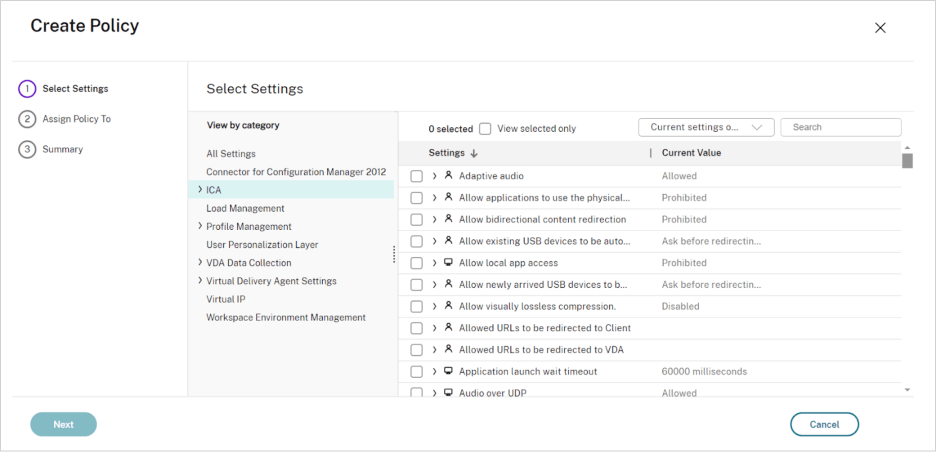
Performance observability
Users can observe enterprisewide performance to support data-driven decision-making. These features of the platform provide actionable insights aimed at reducing mean time to detect (MTTD), mean time to resolve (MTTR), and root cause analysis (RCA). The platform’s Agent monitoring features offer a lightweight approach to tracking physical, virtual client, and server operating systems with detailed analysis across application processes, web apps, network operations, and OS metrics.
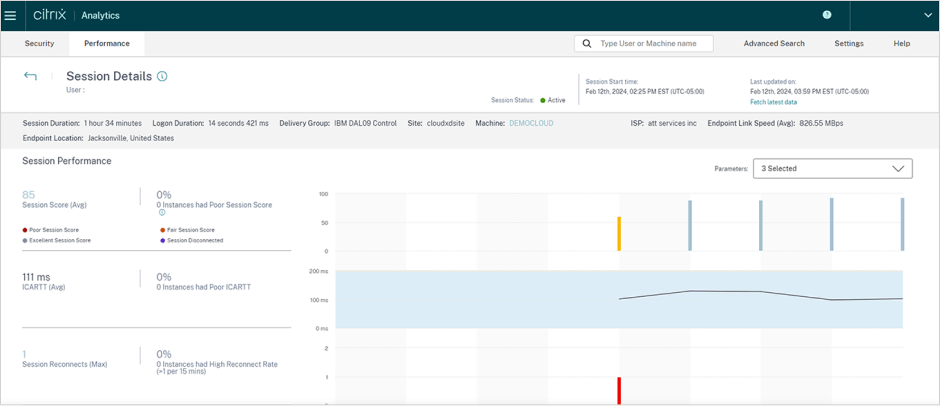
Security analytics
The platform also detects compliance risks by monitoring, identifying, and thwarting them in real-time. Its session insights feature includes clipboard activity, file transfers, and printing patterns linked with user behavior and session initiation details. These features can be used to identify anomalies and assign individualized risk scores. Its session recording feature provides safeguards against compliance breaches and security incidents.
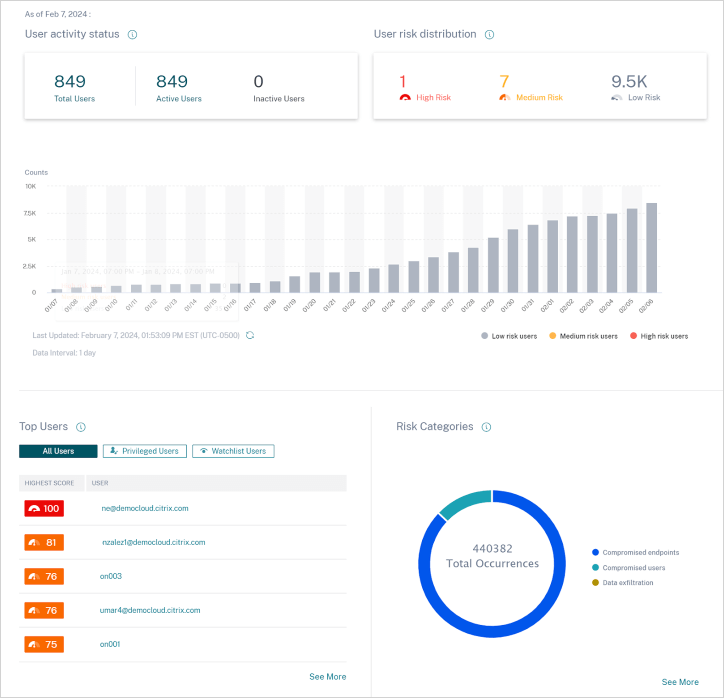
uberAgent
uberAgent delivers comprehensive insights into the performance of physical and virtual Windows and MacOS clients or server operating systems. As a lightweight agent, it delivers detailed metrics on boot and logon duration, process startup time, application responsiveness, usage statistics, network reliability, and remote protocol performance.
From small-scale deployments to expansive global infrastructures accommodating up to 1.5 million users, it scales to meet a wide range of needs. Integrated with Splunk Enterprise, Splunk Cloud, and similar systems, it offers specialized dashboards tailored to specific use cases, including threat detection.

Secure private access
Users gain zero-trust access (ZTNA) with adaptive access to all approved applications — whether web-based, SaaS, or client-server — regardless of whether on-premises or in the cloud. The platform fortifies defenses against network-level attacks, making it easy to improve any security posture in a remote-first world. Its adaptive access policies based on device posture, location, and risk scores keep data safe and secure.
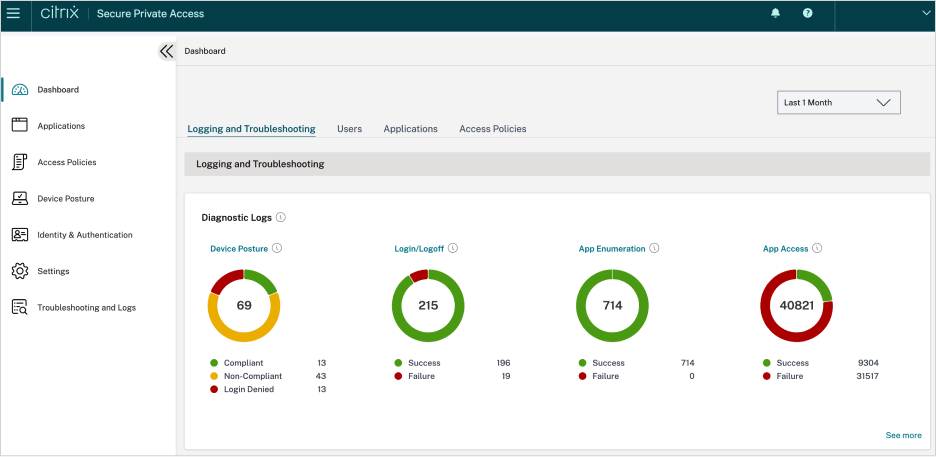
Endpoint management
Citrix’s endpoint management capabilities can control all leading device infrastructures, with over 300 policies for security and advanced mobile device management compliance for context-aware security on Windows, Apple iOS, macOS, iPadOS, and Android devices. Citrix claims this feature maintains a 99.9% uptime SLA, so users almost always stay connected.
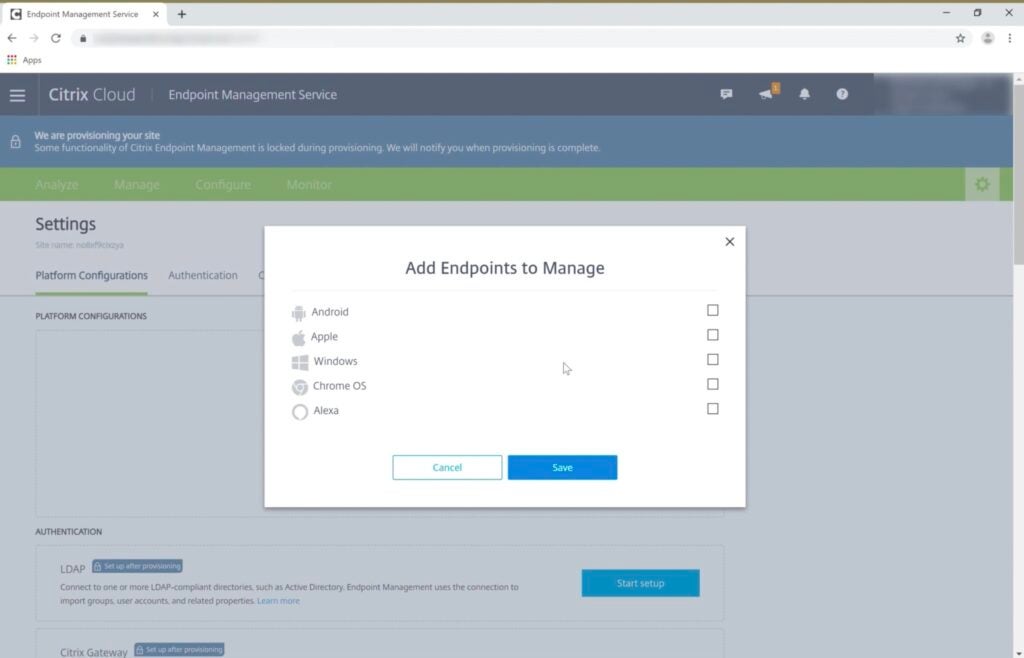
NetScaler application delivery and security
NetScaler delivery provides secure remote access for both internal- and external-facing applications. As a web application delivery controller (ADC), it makes applications run more efficiently, reducing the computational burden on server processing and enhancing application performance. Simplifying the reallocation of throughput, it ensures optimal utilization of resources regardless of evolving business requirements and deployment models.
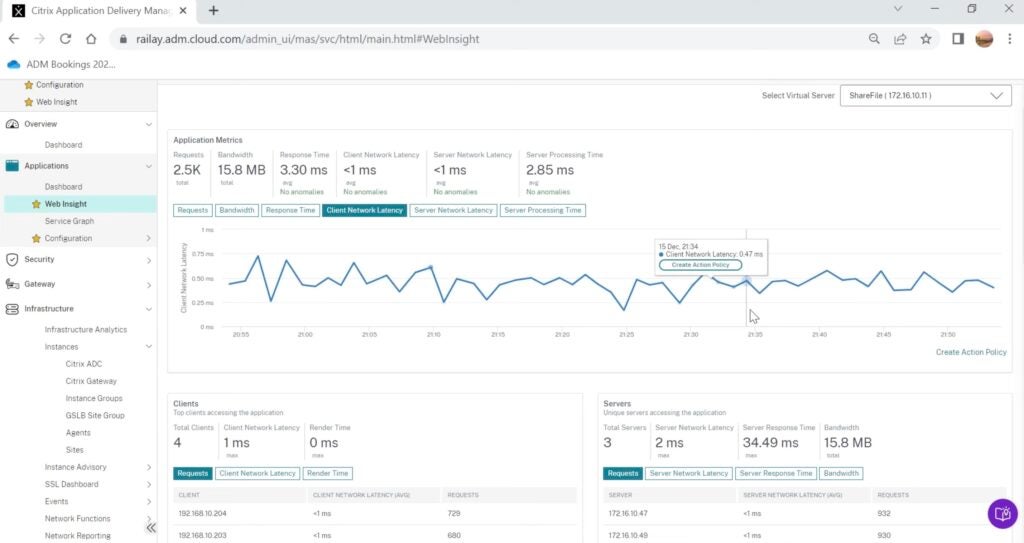
How Citrix has transformed over time
Established in 1989 by a former IBM developer, Citrix initially focused on developing remote access software. Since then, it has evolved into a multinational corporation offering a wide range of digital workspace and networking solutions that provide secure and efficient remote collaboration and access to applications and data.
Here are some key milestones in the company’s evolution:
Early years
During its inception in 1989 as a Microsoft collaborator, Citrix introduced Citrix Multiuser, which pioneered remote access to software on servers for multiple users across diverse operating systems. As the system was poised to launch in 1991, Microsoft’s transition from OS/2 to Windows posed a threat to Multiuser’s compatibility, all but making it inoperable.
Through strategic backing from industry giants like Intel and others, Citrix navigated this challenge, reengineering Multiuser to harmonize with Microsoft’s evolving Windows landscape.
Mid and late 90s meteoric rise
The mid-1990s heralded Citrix’s meteoric rise as a pioneering leader in thin remote access technology, distinguishing itself among a scant number of competitors. By the late 1990s, the adoption of Citrix’s thin-client model surged, propelling its customer base to an astonishing 15 million.
Expansion through strategic acquisitions
As the new millennium dawned, Citrix embarked on a transformative path of acquisitions, commencing with Sequoia Software in 2001 and Expert City in 2003. Its spree of acquisitions continued over subsequent years, with over a dozen companies joining Citrix’s fold, facilitating its expansion into diverse markets.
In a groundbreaking move in 2007, it ventured into server and desktop virtualization by acquiring XenSource. Subsequent acquisitions bolstered its foothold in the cloud and Infrastructure as a Service (IaaS) domains, including VMLogix in 2010 and Netviewer in 2011, marking its foray into the European SaaS arena.
Citrix’s strategic acquisitions further diversified its portfolio, spanning cloud infrastructure with Cloud.com in 2011 and desktop virtualization with Kaviza. Its strategic expansions continued into the mobile video and telecom sectors with ByteMobile and Zenprise acquisitions in 2012, laying the groundwork for the launch of XenMobile in 2013.
In a bid to optimize virtual desktop and application delivery over wireless networks, Citrix acquired Framehawk in 2014, while ScaleXtreme bolstered its cloud offerings with auto-scaling and patching functionalities.
Divestment of GoTo product line
Another significant milestone occurred in 2016 when Citrix divested its GoTo product line to its subsidiary, GetGo, through a deal with LogMeIn.
Partnership with Google
In 2017, Citrix expanded its 2011 strategic partnership with Google aimed at delivering virtual apps and desktops to Chromebooks to include Google adding support to run Citrix XenApp on Chrome. Later in 2019, Google announced that it would run Citrix’s Workspace app to deploy virtualized apps and desktops on Google Cloud, enabling users to manage virtual machine (VM) provisioning, standardize images, and implement patches in an automated way.
Merger with TIBCO
Fast forwarding to 2022, Citrix embarked on a new redevelopment era, merging with TIBCO to form Cloud Software Group, a portfolio of six privately held software businesses that provide mission-critical software to enterprises at scale.
Release of Universal Hybrid-Multi Cloud subscription
In the following year, Citrix unveiled its Universal Hybrid-Multi Cloud subscription, featuring a comprehensive suite of offerings that included Citrix Virtual Apps and Desktops Premium, Citrix DaaS Premium, NetScaler throughput, and Citrix Endpoint Management. The offerings provided users with efficient application delivery features.
Citrix today
Today, Citrix boasts a staggering 99% adoption rate among Fortune 500 companies, solidifying its position as a preeminent solutions provider for top-tier enterprises. An impressive 75% of internet users traverse through its NetScaler daily, underscoring its role in providing access to online experiences. The company also claims a 67% enhancement rate in resolving outages promptly, showcasing its platform’s effectiveness in fortifying operational efficiency and reliability.
Have customers and partners left Citrix?
In recent years, Citrix has experienced some fluctuations in its partner and customer bases. Factors such as market competition, technological shifts, and evolving customer preferences have contributed to this trend. While smaller partners may have had less than lackluster experiences due to having to generate at least $50,000 in annual sales to maintain partner status, it appears the company is making efforts to respond proactively in addressing partner and customer concerns.
Some of the transformations the company has made to improve its customer and partner relationships include its higher value offerings through its merger with TIBCO, enhanced incentive programs, the addition of bigger-name alliance partners, and improved ties within the channel.
TIBCO merger
Since its merger in Q4 2022 with TIBCO, the company has introduced high-value offerings that consolidate application delivery infrastructure through its platform along with simplified subscription offerings.
Customer and partner incentives
In March 2024, the company announced various incentive programs for customers and partners seeking to transition from VMware and other platform providers to its newly introduced Citrix platform. These incentives include discounts and enhanced usage rights for new and existing customers.
Big-name alliance partners
The company has also ramped up efforts to strengthen its relationships with existing partners and attract new ones through various incentive programs and collaborative ventures. It currently works with top alliance partners, including AWS, Cisco, Google Cloud, HP, IBM Cloud, Microsoft, Nutanix, Okta, Samsung, and SAP, leading system integrators, and global Citrix Ready partners that integrate its solutions for optimized performance and experience.
Tighter ecosystem ties
Its customer-centric approach, focused on prioritizing feedback and actively seeking input from its user and partner communities to refine its products and services, is enabling the company to demonstrate a commitment to innovation, customer satisfaction, and partner engagement.
Who should continue using Citrix?
Citrix remains a robust platform for businesses that require secure, remote access to applications and desktops and various types of users, including:
- Organizations requiring robust virtualization capabilities: Citrix’s virtualization solutions ensure seamless access to critical resources from any location, enhancing productivity and flexibility. Its robust security features safeguard sensitive data, crucial for industries like finance, healthcare, and government.
- Teams that need centralized IT management: IT managers and their teams as well as MSPs benefit from the platform’s centralized management capabilities, which simplify administration and oversight.
- Companies seeking streamlined onboarding: Citrix provides simplified onboarding processes, powerful automation, and design flexibility that scales the hosting of multiple customers all managed within a single platform. This streamlined approach boosts technical bench productivity, enabling swift access and management of app and desktop service performance that Citrix claims is up to 10x faster.
- Users looking to scale or migrate: The platform’s multi-site support enables independent scaling of infrastructure with the flexibility to run multiple versions of XenApp and XenDesktop. The service facilitates upgrades to ensure a simple, low-risk upgrade and migration path.
- MSPs in need of rapid customer onboarding: MSPs can swiftly onboard new customers and applications, assign offerings with ease, and manage assignments across multi-tenant sites from a single management portal. They can gain detailed insights into service usage and customer assignments and provide fast service delivery.
- MSPs and others seeking continuous delivery: Users gain optimized multi-tenant hosted apps and desktop delivery (HaaD) services that promote continuous delivery of services and offer enhanced support, risk management capabilities, and reliable performance even during upgrades and updates.
- MSPs that appreciate an extensive support network: Citrix’s extensive support network and commitment to continuous improvement help users operate efficiently. By incorporating Citrix into their service portfolio, MSPs can enhance their value proposition, attract more clients, and solidify their position as a trusted IT partner.
Bottom line: A centralized, intelligent workspace that empowers MSPs
As organizations become more dispersed and digitally enabled, MSPs and system integrators can leverage Citrix’s secure, flexible, reliable, and cost-effective tools for optimizing application delivery in a hybrid multi-cloud environment. They can address many of the most challenging enterprise security and end-user threats, protecting applications from unauthorized access, network-level threats, browser-based attacks, and more.
The company’s solutions unify applications and data into one intelligent workspace that offers virtualization solutions that enable control of virtual machines, applications, and security from anywhere. These capabilities give MSPs the app and desktop experiences they can access on any device, over any network, for multiple clients, across any industry. Learn more about the company’s platform, solutions, resources, support, and partner website on its website.
Any way you slice it, Citrix is positioning itself to regain lost ground and foster sustained growth in a competitive market landscape. The company serves more than 16,000 million users and thousands of organizations rely on its offerings to keep their apps available, their data safe, and their people productive.
Looking for ways to enhance your business efficiency and customer offerings? Check out our article on NVIDIA’s AI platform and the many application features it affords.



